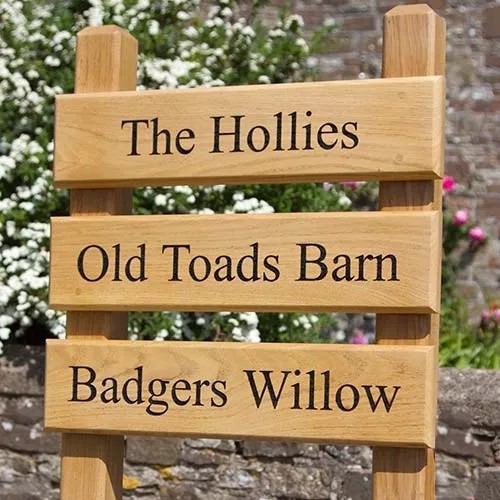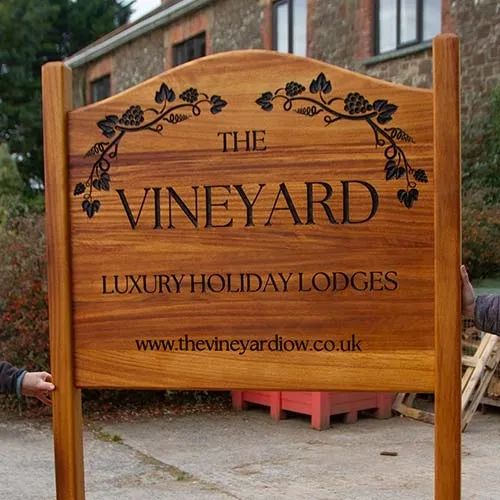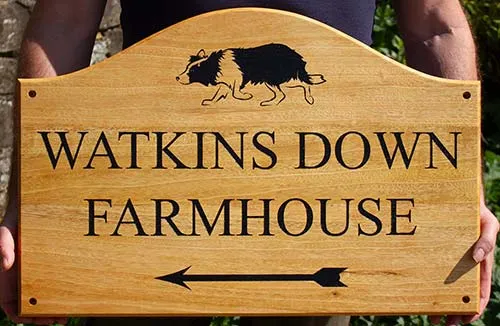The Sign Maker: Timbers for Wooden Signs, Memorials, Engraved Plaques & Large Signage
Home > Wooden Signs > Timbers for Wooden Signs, Memorials, Engraved Plaques & Large Signage

Oak, Cherry, Sycamore, Douglas Fir, Chestnut, Cedar, Sapele, Iroko, Opepe, Balau & Eucalyptus
All the above timbers can be used to make wooden signs. They all have their own unique character and look, but each has a different set of properties, making them useful in different situations. Each has advantages and disadvantages.
We keep most of the timbers in stock in a range of sizes. For large wooden signs the timber is planed to an appropriate thickness and the boards are jointed. This creates a stable wooden sign that resists twisting and bowing.
They all need to be maintained if they are to stay looking lovely, but the high oil timbers - Red Cedar, Iroko, Opepe and Balau can be left untreated to naturally weather often to a greyish colour.
Click here for wood treatments and finishes
Oak
The English oak has a majesty all of its own. It has been used for generations for building the strongest ships and adorning the finest houses. It is a hard, heavy and durable hard wood. Although generally having a coarse straight grain, it can have wonderful variations in grain, texture and colour and small pin knots and burrs are an attractive and acceptable part of its appearance.
Although very durable it does need to be maintained - if water creeps in, fungal activity will cause the grain to blacken.
Oak is very beautiful and the most popular timber for wooden signs. Click here for Extra Large Oak Signs
Iroko
Iroko is similar to teak in appearance. It has a colour which can vary from pale golden brown to dark chocolate brown and medium to coarse texture with an interlocking grain that often produces interesting patterns.
It is a medium density timber which is very stable, naturally oily and therefore highly durable and ideal for external signs. It is another timber which can be left untreated. It is used widely for boat building, window frames as well as cabinet work and furniture making.
An attractive timber which is naturally oily and can be left untreated. However, to keep it looking as new, wipe over with Devon Oil every couple of months.
Sapele
Pronounced Sa peel e, this species is another of the world's most extraordinary hardwoods. Its rich, lustrous, and variable reddish-brown colour give it a mahogany-like appearance. However unlike most mahoganies, Sapele has substantially less movement in service. It is also even harder than oak. It is moderately durable and should always be maintained with oil or varnish. As it is so stable we do use Sapele for our painted signs.
A rich mahogany-like appearance which looks great with white lettering.
Douglas Fir
t has a reddish brown to orange colour with a prominent grain and is characterized by exceptional strength, hardness and moderate durability. It is not only very tough but also water resistant, which makes it useful in exposed situations where maintenance is difficult.
A tough strong softwood with a distinct grain, best used for large signs.
Opepe
It is commonly used for piling and decking in wharves and docks, jetty and marine work, boat building, wagon bottoms, exterior and interior joinery, furniture, cabinet work, and decorative turnery. Remarkably resilient, it can be left untreated, even in contact with soil, and will usually age to a silver-grey patina over time.
This attractive, oil-rich timber is exceptionally durable and versatile.
English Cherry
A beautiful, rich brown hardwood of exceptional quality, though often hard to source. It is close-grained, resists warping and shrinking, and develops a deeper, richer tone with age, reddening when exposed to sunlight. This timber is moderately durable and requires regular maintenance
Chestnut
Sweet chestnut is traditionally known as poor mans oak! However we don't look at it this way - more of an interesting alternative to oak. It certainly does look very similar to oak with a fairly dense grain, although it is not as heavy. It also has a high tannin content that makes it very durable. An advantage over oak is that it does not tend to blacken if not treated properly.
Red Cedar
Cedar renowned for its natural beauty and outstanding physical properties that make it one of the world's most unique softwood species. This exceptionally beautiful wood has natural colorings in mellow ambers, reddish cinnamon's and rich sienna browns.
Slow growing and naturally durable, Red Cedar has one of the longest life spans of the softwoods. The heartwood contains substances that are toxic to the decay causing fungi
Softer than oak, yet very stable and long lasting - cedar can be left untreated and matures to silver grey colour.
Below are three more timbers we use occasionally. If you would like a sign made in one of these - aask for a quote.
Sycamore
There is no colour difference between Sycamore's sapwood and heartwood, the timber being white, or yellowish-white. The texture is fine and it has a similar high strength to oak
The lightest timber we use, excellent for internal plaques - must be well maintained if outside
Balau
It is a heavy, hard and very dense timber. It main disadvantage are the small black pin holes which can be characteristic of this timber.
Although not as attractive as some timbers, Balau is the heaviest and most durable timber we can use. Priced as oak.
Red Grandis or Eucalyptus
It is a straight grained, durable hardwood suitable for varnishing or painting. It is a good eco friendly option as it is fast growing -a great absorber of carbon dioxide
It is a stable timber so ideal for painted signs.
Click here for wood treatments and finishes
Related Links
ALTERNATIVES:

Place your Order
 Use the Online Shop
Use the Online Shop
Its easy - Pay by Card, Cheque or Online Banking
 Signs - 01769 561355
Signs - 01769 561355
Memorials - 01769 618585
 By email - sales@sign-maker.net
By email - sales@sign-maker.net
 Design Your Own Sign / Plaque:
You create the design - we send you a quote
Design Your Own Sign / Plaque:
You create the design - we send you a quote
Easy Pay: Tell us what you want - we will send you the price with an Easy Pay link













